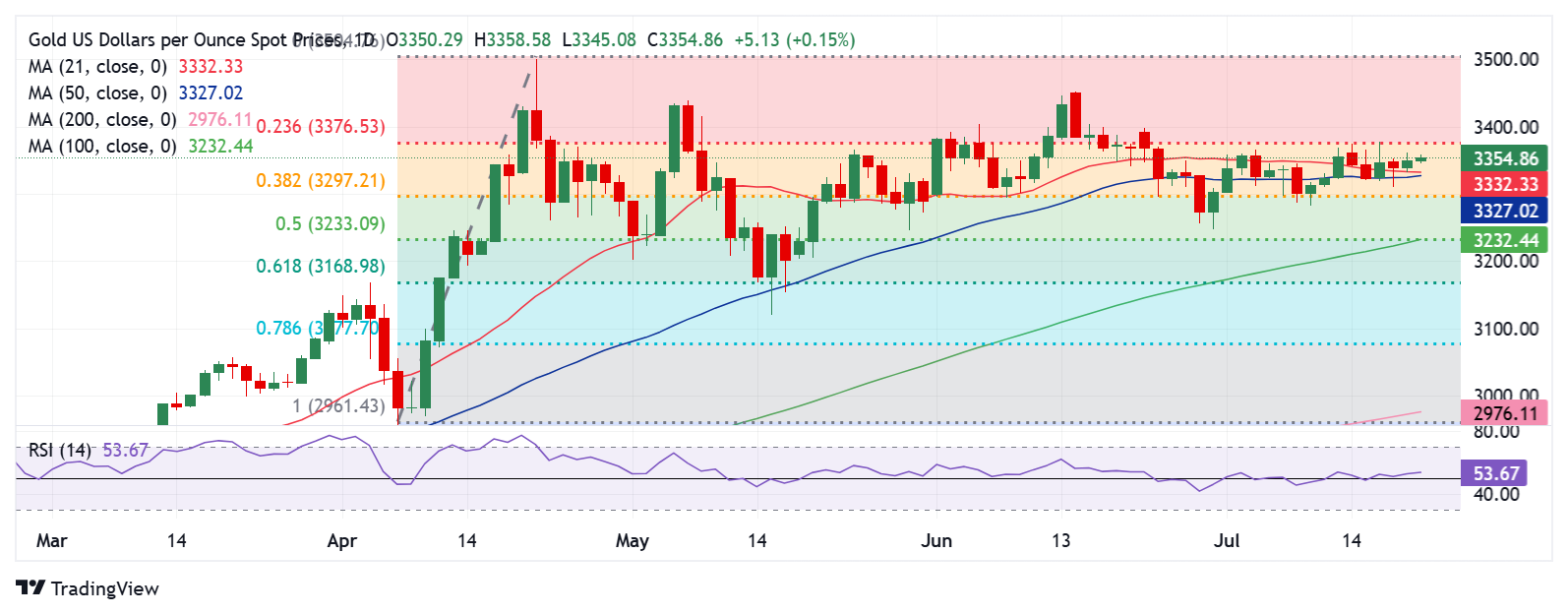
- Gold price looks to build on last week’s rebound from six-day lows, retakes $3,350.
- The US Dollar holds steady amid a slightly upbeat mood, but tariff angst lingers.
- Gold price stays above key daily moving averages as the RSI holds above the midline.
Gold price is extending the turnaround from six-day lows of $3,310 early Monday, making another attempt above the $3,350 barrier.
Gold price looks north amid trade woes, Trump-Powell spat
Gold buyers keep the upper hand as the US Dollar (USD) pauses its late rebound on Friday, entering a consolidative mode, with attention turning to Tuesday’s speech by US Federal Reserve (Fed) Chairman Jerome Powell for further trading impetus.
Monday’s data-docket is a quiet one, and hence, tariff-related developments will continue to dominate the sentiment around the USD-denominated Gold price.
Traders remain expectant of encouraging earnings reports from American tech giants, including Alphabet Inc., due later this week.
Despite a mild optimism, investors remain wary about US President Donald Trump’s tariff plans against the European Union (EU) as the August 1 deadline approaches.
US Commerce Secretary Howard Lutnick said Friday that he is still confident a deal could be reached with the EU.
The Financial Times (FT) late Friday reported three people briefed on the talks as saying that Trump is eyeing at least a minimum tariff of 15% to 20% in a deal with the EU.
Meanwhile, the Wall Street Journal (WSJ) quoted some sources reporting on Monday that “US officials have informed the EU’s trade chief that President Trump is likely to demand further concessions in ongoing trade talks, including a higher baseline tariff of 15% or more on most European goods, a significant increase from the previously discussed 10%.”
In response, the bloc warned of strong retaliation if no deal is reached with the US by August 1, per the WSJ.
Lingering tariff tensions bode well for the traditional safe-haven Gold price as markets digest the Japanese political drama.
The Japanese ruling coalition, the Liberal Democratic Party (LDP) and its ally Komeito, lost control of the upper house in an election on Sunday, further weakening Prime Minister Shigeru Ishiba’s hold as a tariff deadline looms, Reuters reports.
The Japanese Yen (JPY) experienced ‘buy the fact’ trades on the expected election outcome, dragging USD/JPY lower. The renewed USD/JPY weakness capped the USD’s recovery, helping Gold price build on the previous upswing.
Furthermore, the ongoing criticism of Fed Chair Powell by Trump also prompts traders to temporarily forgo the USD in search of safety in the bright metal.
Gold price technical analysis: Daily chart

As observed on the daily chart, Gold price is holding comfortably above all major Simple Moving Averages (SMA) while the 14-day Relative Strength Index (RSI) points higher above the midline.
The technical setup, therefore, appears in favor of Gold buyers, with the immediate resistance located at the 23.6% Fibonacci Retracement (Fibo) level of the April record rally at $3377.
Further north, the $3,400 round level will challenge bearish commitments, with more upside opening toward the static resistance at around $3,440.
Alternatively, strong support is aligned at around $3,330, the confluence of the 21-day SMA and the 50-day SMA.
Sellers must find a strong foothold below that demand area to test the 38.2% Fibo level of the same rally at $3,297 before targeting the July low of $3,283.
Tariffs FAQs
Tariffs are customs duties levied on certain merchandise imports or a category of products. Tariffs are designed to help local producers and manufacturers be more competitive in the market by providing a price advantage over similar goods that can be imported. Tariffs are widely used as tools of protectionism, along with trade barriers and import quotas.
Although tariffs and taxes both generate government revenue to fund public goods and services, they have several distinctions. Tariffs are prepaid at the port of entry, while taxes are paid at the time of purchase. Taxes are imposed on individual taxpayers and businesses, while tariffs are paid by importers.
There are two schools of thought among economists regarding the usage of tariffs. While some argue that tariffs are necessary to protect domestic industries and address trade imbalances, others see them as a harmful tool that could potentially drive prices higher over the long term and lead to a damaging trade war by encouraging tit-for-tat tariffs.
During the run-up to the presidential election in November 2024, Donald Trump made it clear that he intends to use tariffs to support the US economy and American producers. In 2024, Mexico, China and Canada accounted for 42% of total US imports. In this period, Mexico stood out as the top exporter with $466.6 billion, according to the US Census Bureau. Hence, Trump wants to focus on these three nations when imposing tariffs. He also plans to use the revenue generated through tariffs to lower personal income taxes.
Information on these pages contains forward-looking statements that involve risks and uncertainties. Markets and instruments profiled on this page are for informational purposes only and should not in any way come across as a recommendation to buy or sell in these assets. You should do your own thorough research before making any investment decisions. FXStreet does not in any way guarantee that this information is free from mistakes, errors, or material misstatements. It also does not guarantee that this information is of a timely nature. Investing in Open Markets involves a great deal of risk, including the loss of all or a portion of your investment, as well as emotional distress. All risks, losses and costs associated with investing, including total loss of principal, are your responsibility. The views and opinions expressed in this article are those of the authors and do not necessarily reflect the official policy or position of FXStreet nor its advertisers. The author will not be held responsible for information that is found at the end of links posted on this page.
If not otherwise explicitly mentioned in the body of the article, at the time of writing, the author has no position in any stock mentioned in this article and no business relationship with any company mentioned. The author has not received compensation for writing this article, other than from FXStreet.
FXStreet and the author do not provide personalized recommendations. The author makes no representations as to the accuracy, completeness, or suitability of this information. FXStreet and the author will not be liable for any errors, omissions or any losses, injuries or damages arising from this information and its display or use. Errors and omissions excepted.
The author and FXStreet are not registered investment advisors and nothing in this article is intended to be investment advice.







